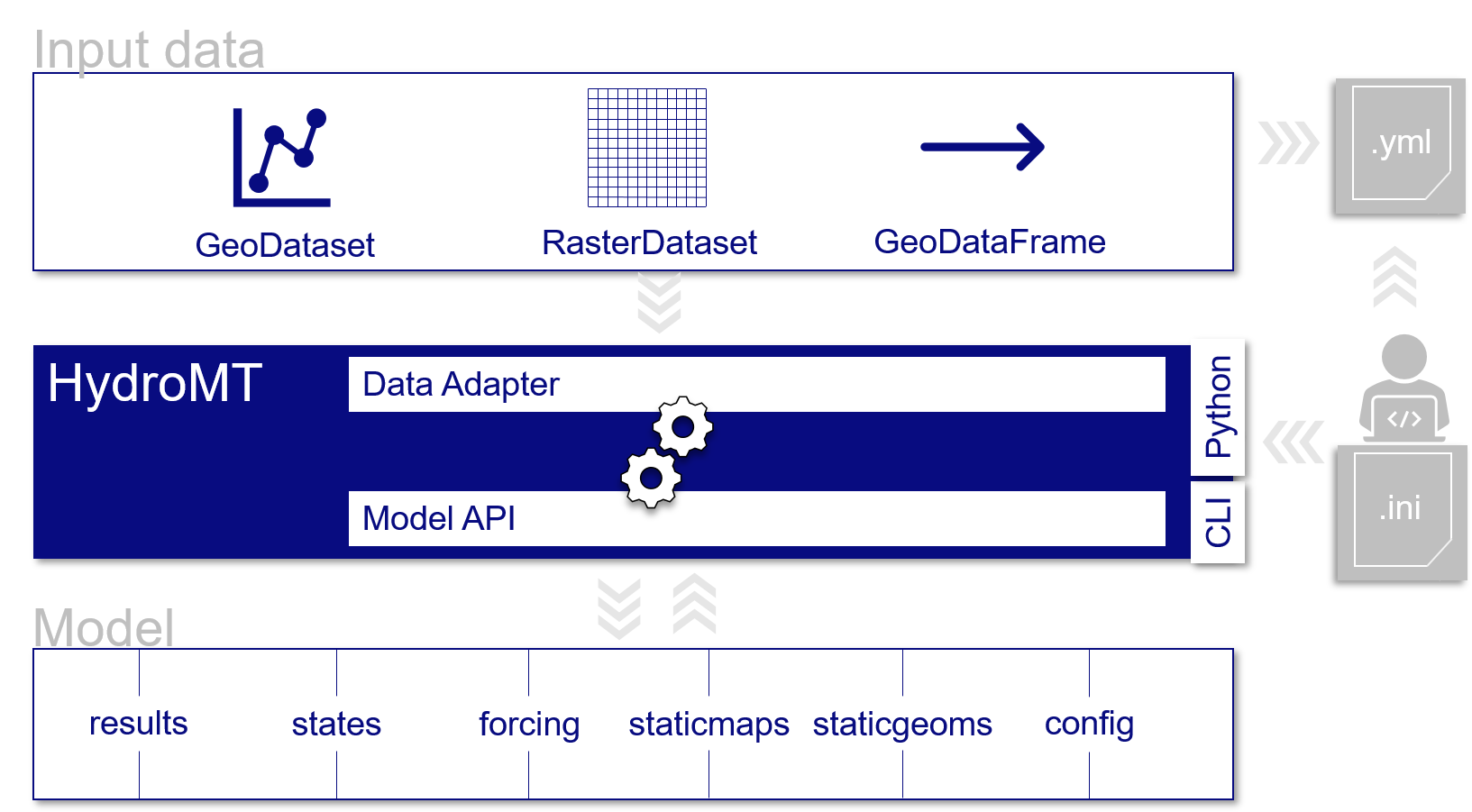User guide#
HydroMT is a Python package that aims to facilitate the process of building models and analyzing model results by automating the process to go from raw data to model data. It is an interface between user, data and hydro models.
HydroMT is organized in the following way:
Input Data
HydroMT is data-agnostic through the Data Adapter that reads a wide range of data formats and unifies the input data, see Working with data in HydroMT. Datasets are listed and passed to HydroMT in a user defined data catalog yaml file. HydroMT also provides several pre-defined data catalogs with mostly global datasets that can be used as is, but note that not all data is openly accessible.
Models
HydroMT defines a model-agnostic Model API which provides a common interface to data components of a model such as (static) grids, vectors, forcing, states and simulation configuration, see Working with models in HydroMT. Models can be built from scratch or updated based on a pipeline defined in a model configuration .ini file. The Model API for each supported model and methods to build or update that model are implemented in model plugins that need to be installed alongside HydroMT to work with a supported model. Available model methods vary per model plugin and are documented for each plugin at their respective documentation websites.
Methods and workflow
Methods and workflows are the engine of HydroMT. Methods provide the low-level functionality, only accessible through the Python interface, to do the required processing of common data types such as grid and vector data. Workflows combine several methods to go from raw input data to a model component. Examples of workflows include the delineation of hydrological basins (watersheds), conversion of landuse-landcover to model parameter maps, etc.
A user can interact with HydroMT through the following interfaces:
Command Line Interface (CLI)
The CLI is a high-level interface to HydroMT. It is used to run HydroMT methods such as build, update or clip.
Python Interface
While most common functionalities can be called through the CLI, the Python interface offers more flexibility for advanced users. It allows you to e.g. interact directly with a model through the Model API and apply the many methods and workflows available. Please find all available functions here

Schematic of HydroMT architecture#
Terminology#
HydroMT and this documentation use a specific terminology to describe specific objects or processes.
Term |
Explanation |
|---|---|
Command Line Interface (CLI) |
high-level interface to HydroMT build, update and clip methods. |
Configuration (HydroMT) |
(.ini) file describing the complete pipeline with all methods and their arguments to build or update a model. |
Data catalog |
A set of data sources available for HydroMT. It is build up from yaml files containing one or more data sources with information about how to read and optionally preprocess the data and meta-data about the data source. |
Data source |
Input data. To be processed by HydroMT, data sources are listed in yaml files. |
Model |
A set of files describing the schematization, forcing, states, simulation configuration and results for any supported model kernel. |
Model attributes |
Direct properties of a model, such as the model root. They can be called when using HydroMT from python. |
Model component |
A model is described by HydroMT with the following components: staticmaps (regular grid data), staticgeoms (vector data), forcing, results, states, config |
Model plugin |
Model software for HydroMT can build and update models and analyze its simulation results. For example wflow, sfincs etc. |
Model kernel |
The model software to execute a model simulation. This is not part of any HydroMT plugin. |
Region |
Argument of the build and clip CLI methods that specifies the region of interest where the model should be prepared / which spatial subregion should be clipped. |